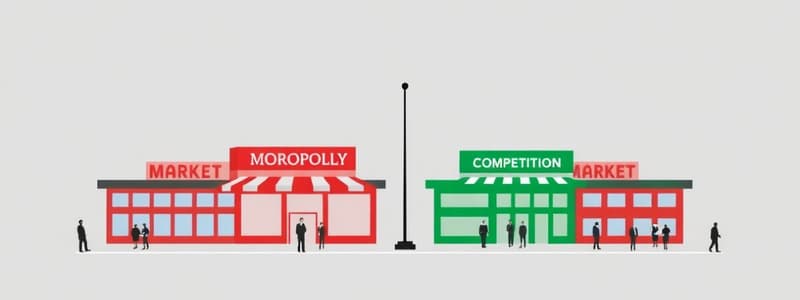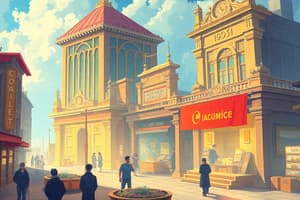Podcast
Questions and Answers
Which of the following best describes a monopoly?
Which of the following best describes a monopoly?
- A market with a single seller and no close substitutes (correct)
- A market with free entry and exit of firms
- A market where all firms sell identical products
- A market with many sellers and many buyers
In perfect competition, firms produce at the point where:
In perfect competition, firms produce at the point where:
- Price is higher than marginal cost
- Marginal cost equals average cost
- Price equals total cost
- Marginal cost equals marginal revenue (correct)
A key characteristic of a perfectly competitive market is:
A key characteristic of a perfectly competitive market is:
- High barriers to entry
- Price-taking behavior (correct)
- Control over market prices
- Differentiated products
A monopolist faces:
A monopolist faces:
In the long run, firms in perfect competition:
In the long run, firms in perfect competition:
Which of the following is NOT a barrier to entry in a monopoly?
Which of the following is NOT a barrier to entry in a monopoly?
In perfect competition, the price of a product is determined by:
In perfect competition, the price of a product is determined by:
Perfect competition leads to an efficient allocation of resources because:
Perfect competition leads to an efficient allocation of resources because:
Flashcards
Monopoly
Monopoly
A market structure where a single seller dominates and there are no close substitutes for the product.
Perfect Competition
Perfect Competition
A market structure characterized by many buyers and sellers, homogeneous products, free entry and exit, and perfect information.
Price-taking Behavior
Price-taking Behavior
Firms in perfect competition cannot influence the market price because they are too small compared to the market.
Barriers to Entry
Barriers to Entry
Signup and view all the flashcards
Economic Profit
Economic Profit
Signup and view all the flashcards
Deadweight Loss
Deadweight Loss
Signup and view all the flashcards
Marginal Revenue
Marginal Revenue
Signup and view all the flashcards
Market Demand and Supply
Market Demand and Supply
Signup and view all the flashcards
Study Notes
Monopoly vs. Perfect Competition
- Monopoly: A market structure with a single seller and no close substitutes. Buyers have no choice.
- Perfect Competition: A market structure with many sellers, identical products, free entry/exit, and price-taking behavior.
- Key Characteristics:
- Monopoly: Single seller, barriers to entry, downward-sloping demand curve, significant market power.
- Perfect Competition: Many sellers, identical products, free entry/exit, price determined by market forces (demand and supply).
Q&A: Monopoly and Perfect Competition
-
Question 1: Which best describes a monopoly?
- Correct Answer: b) A market with a single seller and no close substitutes.
-
Question 2: In perfect competition, firms produce where:
- Correct Answer: b) Marginal cost equals marginal revenue.
-
Question 3: A key characteristic of perfect competition is:
- Correct Answer: c) Price-taking behavior.
-
Question 4: A monopolist faces:
- Correct Answer: b) A downward-sloping demand curve.
-
Question 5: In the long run, perfectly competitive firms:
- Correct Answer: b) Earn zero economic profits.
-
Question 6: Which is NOT a barrier to entry in a monopoly?
- Correct Answer: c) Free entry and exit.
-
Question 7: In perfect competition, the price is determined by:
- Correct Answer: c) Market demand and supply.
-
Question 8: A monopolist maximizes profit by producing where:
- Correct Answer: b) Marginal revenue equals marginal cost.
-
Question 9: Perfect competition leads to efficient resource allocation because:
- Correct Answer: b) Firms produce at the lowest possible cost.
-
Question 10: Which is true about monopolies?
- Correct Answer: c) Monopolies create deadweight loss in the market.
Studying That Suits You
Use AI to generate personalized quizzes and flashcards to suit your learning preferences.
Description
Test your knowledge on the key characteristics and concepts of monopoly and perfect competition in market structures. This quiz covers definitions, essential features, and the differences between these two economic models.




